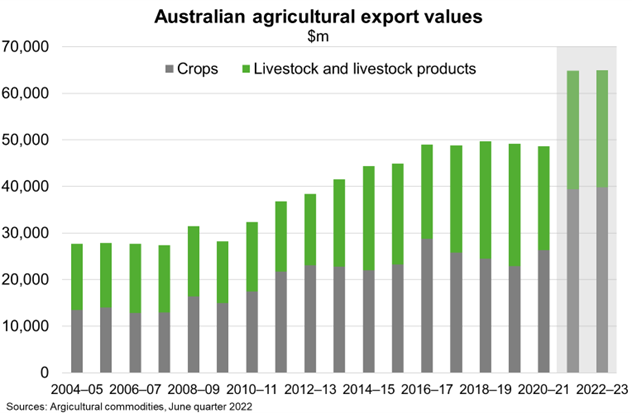Australia—Record agricultural exports but rising global food insecurity
The Department of Agriculture, Water and the Environment (ABARES) forecasts the value of agricultural exports to increase 33% to a record $65 billion in FY2023. This reflects high world prices and favourable Australian conditions, lifting exports of crops (Chart). Exports are expected to remain resilient to global shipping and supply chain disruptions and the costs associated with trade diversification. Indeed, despite such challenges, Australia’s monthly exports over the year to March were a record average 3 million tonnes of wheat, barley and canola combined.
Food prices have been rising for two years and, as of May 2022, were 78% above their average between 2015 and 2019. ABARES expect prices to rise further in FY2023. The world production outlook is poor; the ratio of food supply to demand is expected to fall to its lowest level in 8 years (for the 12 most important agricultural commodities) with continued poor seasonal conditions and higher input costs eroding global production prospects. Disruptions to agricultural exports from Russia and Ukraine have worsened the supply outlook. High prices and supply shortages have seen some countries introduce prohibitive trade measures; 23 countries have imposed export restrictions affecting over 16% of globally traded calories since Russia’s invasion of Ukraine.
Rising food insecurity, particularly among poor urban households, will impose long-lasting costs on many lower income countries. Malnutrition erodes human capital and inadequate food access can lock economies into widespread, low productivity subsistence farming. For instance, government workers in Sri Lanka were recently given one day off per week to grow crops at home in a bid to ease food and fuel shortages. Australia is well positioned to provide additional supply, particularly to established markets in southeast Asia. Still, the World Bank estimate there will be 75 million more people in extreme poverty by the end of this year relative to pre-pandemic projections.


